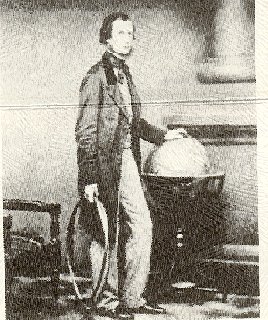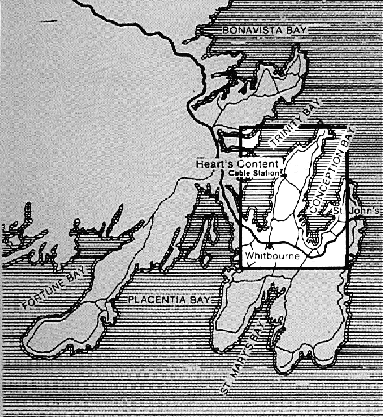

By mid-century, a vast network of telegraph lines connected the major population centres in Europe and on the North American mainland. The gulf between them of the 2,000 mile wide Atlantic ocean remained a major challenge to the science and enterprise of the Victorian era.
A trans-Newfoundland telegraph line with a submarine cable link across the Cabot Strait to Nova Scotia was projected in 1851 by Frederick Gisborne, an English telegraphic engineer. With Gisborne's bankruptcy three years later, responsibility for the project was assumed by an American syndicate headed by Cyrus W. Field. For Field, the Cabot Strait cable was simply a beginning: from the outset of his involvement in the enterprise he determined to complete a submarine trans-Atlantic cable line, connecting Europe and America via Newfoundland.

Cyrus W. Field in 1858
After one abortive attempt in the summer of 1855, Field's New York, Newfoundland and London Telegraph Co. succeeded in laying a submarine cable across the Cabot Strait in 1856. Also completed that year was the Company's trans-Newfoundland surface line. The entire operation, which established a telegraphic link between New York and St. John's, cost over a million dollars.
Meanwhile, Cyrus Field busied himself in England with the technical problems of submarine cable design and with financial negotiations to raise the estimated 1 1/4 million dollars required for the Atlantic cable-laying operation. Drawing on the experience of English cable pioneers, it was decided to fabricate the cable using a core conductor of stranded copper, insulated with layers of "gutta percha", a rubber-like extract recently discovered in Malaya. This highly durable material possessed great insulating properties, and was one of the first industrial "plastics" ever used on a commercial scale. It was protected with an outer covering of pitch, tar and wax and an armoured sheath of spirally-wound heavy gauge iron wire.
The British and American governments supported the venture with financial Guarantees and with provision of steam powered ships specially modified for cable laying. In August 1857 the USS Niagara and HMS Agamemnon made two unsuccessful attempts to lay the cable from its Eastern terminus at Valentia, Ireland to the Western landfall at Bull Arm in Newfoundland's Trinity Bay. Re-equipped with improved machinery, the same two vessels made three further abortive attempts in June 1858. A sixth attempt was made in July when, despite severe mid-Atlantic storms, each vessel landed its cable end successfully at the assigned destinations.

The momentous achievement occasioned great public rejoicing in New York and London. Inaugural messages of congratulation were exchanged by U.S. President Buchanan and Queen Victoria, and Cyrus Field was feted as the man of the hour. However, even as its success was celebrated, some unknown rupture ruined the cable's conductivity. Within two months it was dead.
After such a disappointment, raising capital for yet another attempt was a slow business, even for a promotor of Cyrus Field's tenacity. The outbreak of the American civil war, which discouraged speculation in that country, added to these difficulties. In 1864, however, fabrication of a new Atlantic cable was begun, superior to the 1858 model in terms of insulation, tensile strength, lightness and non-corrosiveness. It was also manufactured in a single length, 2300 nautical miles long and weighing 5000 tons.
To carry and lay such a cable there was only one suitable vessel then in existence, the mammoth Great Eastern . Launched in 1858, she was almost 700 feet overall, 22,500 tons displacement and five times the size of the largest ship then afloat.
In July 1865 the Great Eastern made a first attempt to lay the new cable from Valentia to the re-sited Western terminal at Heart's Content, Trinity Bay. After two unfortunate incidents of suspected sabotage, the voyage ended in failure with the loss of the cable 1200 miles out. After more than a week of trying to grapple the lost cable, during which time all the vessel's lifting gear was also lost, the Great Eastern was compelled to return to England.
Yet another attempt was made in July 1866, again with the Great Eastern, but with an improved galvanized cable of far greater tensile strength. On this occasion the ships of the cable fleet had been equipped with extensive lifting and grappling gear since it was intended to recover and complete the cable lost the previous year. The 1866 expedition passed off with monotonous efficiency, and after an uneventful fifteen days passage, a successful landfall was made at Heart's Content. Pausing in Trinity Bay for two weeks to re-coal, the Great Eastern retraced her course to mid-Atlantic early in August with three consorts. After continual round-the-clock efforts, the 1865 cable was grappled successfully on September 1 stand spliced to the remainder of its original length on board the Great Eastern. A week later the second trans-Atlantic cable was landed at Heart's Content. Elaborate public festivities were organized on both sides of the Atlantic to celebrate the greatest technological achievement of the age.

Other cables were laid in the following decades and the Heart's Content station remained in continual service, becoming a focal centre of Western Union Inc.'s international cable system in the present century. The facility was closed in 1965 after trans-ocean telephone cable and satellite communication reduced it to obsolescence. The site consists of the telegraph building constructed in 1875-76 and a larger extension added by Western Union in 1918-19. On site may be seen instruments and equipment used at Heart's Content, as well as interpretive displays which explain the station's role through almost a hundred years of cable history.
P.P. Box 8700
St. John's, NFLD
A1B 4J6
(709) 729-2460
(709) 583-2160